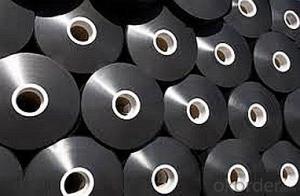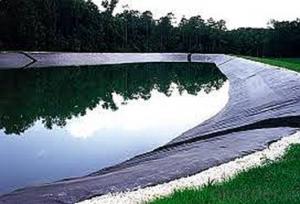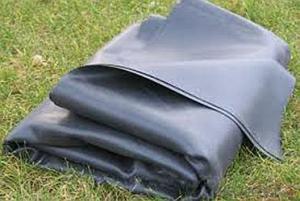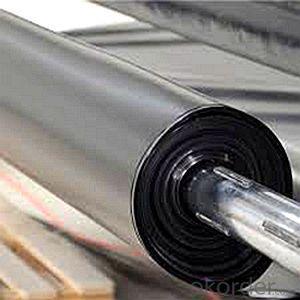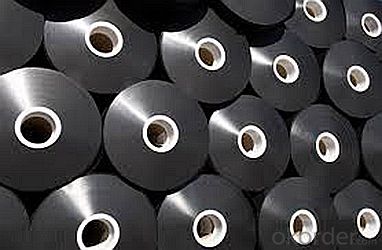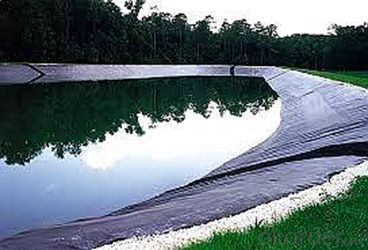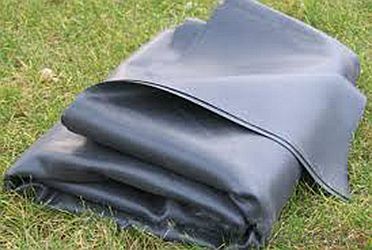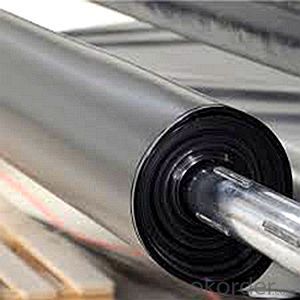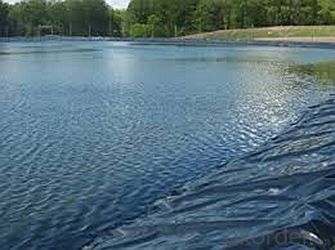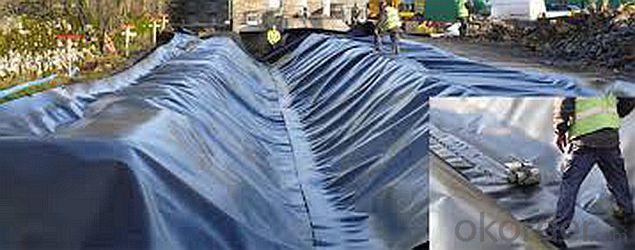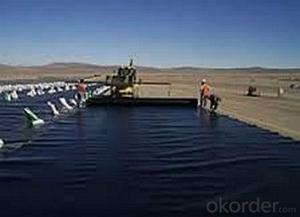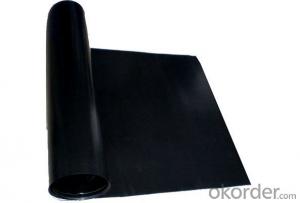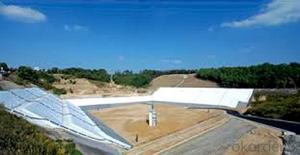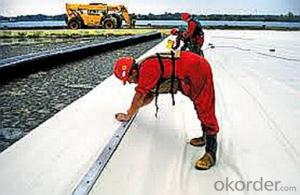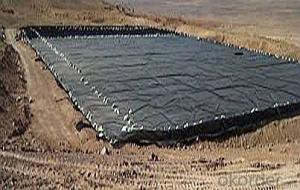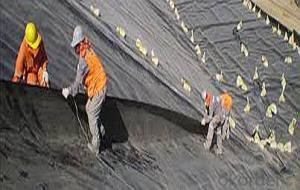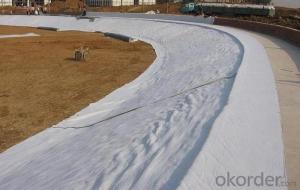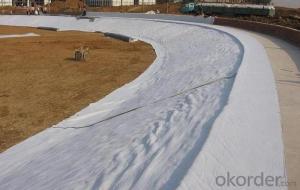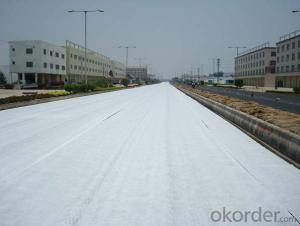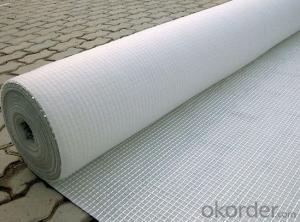High-Density Polyethylene Geomembrane for Waste Liquid - Geotextile Membrane Specification
- Loading Port:
- China main port
- Payment Terms:
- TT OR LC
- Min Order Qty:
- 1000 m²
- Supply Capability:
- 1000000 m²/month
OKorder Service Pledge
OKorder Financial Service
You Might Also Like
Specification
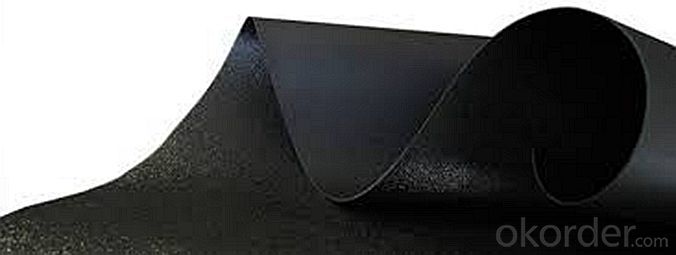
Geomembrane Liners are impermeable membranes used widely as containment liners, pond liners, landfill liners and more. Made in a wide range of sizes from a wide range of material options, these liners are the perfect way to prevent liquids from causing contamination in your location.
serves
Feature:
1. Corrosion resistance, aging resistance, puncture resistance
2. Repairable and recyclable
3. Very low permeability and good flexibility
4. Smooth, UV resistance and no toxic
5. Excellent environmental stress cracking resistance property
6. High tensile strength and elongation
1.On a regular basis or as per your request,we entrust national testing agencies to conduct quality inspections
2. Strictly in accordance with the ISO9001-2008 international quality system standard,we monitor and manage the whole process throughout production,quality testing,and measurement to ensure product quality
3. For quality-related construction delay or substandard construction(except for damage or losses due to customer’s responsibility or irresistible natural disasters),we have refunding,replacement,and repair services.We will respond to customers’ feedbacks on quality issues within 24 hours.
Packaging & Shipping
Packing: PLASTIC FILM INSIDE, AND WOVEN BAG OUTSIDE
Shipping: About 15 days after receipt the deposit
geotextile fabric
permeability,filtration,easy for construction
ISO and CE certificate
Good quality and competitive price
Our Service
FAQ:
Q: What kind of payments does jenor support?
A: T/T, L/C, Cash are accepted.
Q: Do you charge for the samples?
A: Accordeing to our company policy, the samples are free, we only charge the freight fee. And we will return the freight fee during the next order.
Q: Can you produce according to customers' design?
A: Sure, we are professional manufacturer, OEM and ODM are both welcome.
Q: Do you have other products?
A: Yes, please check the pictures:
- Q: Are geotextiles resistant to abrasion?
- Yes, geotextiles are generally resistant to abrasion due to their sturdy and durable construction. They are designed to withstand friction and wear, making them suitable for various applications requiring protection against abrasion.
- Q: What are the different geotextile installation techniques for landfill applications?
- There are several geotextile installation techniques commonly used for landfill applications. These include the direct burial method, where the geotextile is placed directly on the landfill surface and covered with soil or other materials; the geocomposite method, which involves placing a geotextile and a geomembrane together to create a composite liner; the anchor trench method, where the geotextile is anchored in a trench around the perimeter of the landfill; and the slope method, which involves installing the geotextile on the slope of the landfill to prevent erosion. Each technique has its advantages and is chosen based on the specific requirements and conditions of the landfill site.
- Q: What are the different geotextile durability test methods?
- There are several geotextile durability test methods used to assess the performance and longevity of geotextile materials. Some of the commonly used test methods include ASTM D4355 (Oxidative Induction Time), ASTM D1777 (Hydrostatic Puncture Resistance), ASTM D4533 (Trapezoidal Tear Strength), ASTM D4751 (Apparent Opening Size), ASTM D4759 (UV Stability), and ISO 12956 (Cyclic Load Test). These tests evaluate factors such as resistance to oxidation, puncture resistance, tear strength, opening size, UV stability, and cyclic load performance, providing insights into the durability and suitability of geotextile materials for specific applications.
- Q: How do geotextiles help in preventing sinkhole formation?
- Geotextiles help in preventing sinkhole formation by acting as a barrier that reinforces the soil and provides stability. They are placed beneath the soil surface to distribute the load and prevent the movement of soil particles, which is a significant cause of sinkholes. Additionally, geotextiles can improve drainage and filtration, reducing the risk of water accumulation and weakening of the soil, which can also lead to sinkhole formation.
- Q: Sponge city sunken green land in the drilling drainage jacket how to set the amount of geotextile
- Need plastic blind ditch, complete specifications, collar Xiang new materials for your answer
- Q: What are the considerations for geotextile selection in shoreline erosion control?
- When selecting geotextiles for shoreline erosion control, several considerations need to be taken into account. These include the strength and durability of the geotextile, its resistance to UV degradation and chemical exposure, its permeability to allow for proper drainage, and its ability to retain sediment while still allowing for plant growth. Additionally, factors such as cost-effectiveness, installation requirements, and the specific environmental conditions of the shoreline should also be considered in the selection process.
- Q: How do geotextiles help with soil stabilization in construction sites?
- Geotextiles help with soil stabilization in construction sites by providing reinforcement and separation between different soil layers. They act as a barrier, preventing the mixing of different soil layers, which helps maintain the stability and strength of the soil. Additionally, geotextiles distribute the load evenly across the construction site, reducing the potential for soil erosion and settling.
- Q: What are the maintenance requirements for geotextile installations?
- The maintenance requirements for geotextile installations vary depending on the specific project and site conditions. However, in general, some common maintenance requirements for geotextile installations include regular inspection for damage or erosion, ensuring proper drainage and sediment control, removing any debris or vegetation that may accumulate on the geotextile, and addressing any issues or repairs promptly to prevent further damage. It is important to follow the manufacturer's guidelines and recommendations for maintenance to ensure the longevity and effectiveness of the geotextile installation.
- Q: Why do you shop the geotextile during the construction of the road
- Huazhi geotechnical materials manufacturers to answer
- Q: How do geotextiles help in reducing the risk of slope failures?
- Geotextiles help in reducing the risk of slope failures by providing reinforcement and stabilization to the soil. They are used to reinforce the soil layers, prevent erosion, and improve drainage, thereby enhancing the overall stability of the slope.
Send your message to us
High-Density Polyethylene Geomembrane for Waste Liquid - Geotextile Membrane Specification
- Loading Port:
- China main port
- Payment Terms:
- TT OR LC
- Min Order Qty:
- 1000 m²
- Supply Capability:
- 1000000 m²/month
OKorder Service Pledge
OKorder Financial Service
Similar products
Hot products
Hot Searches
Related keywords
